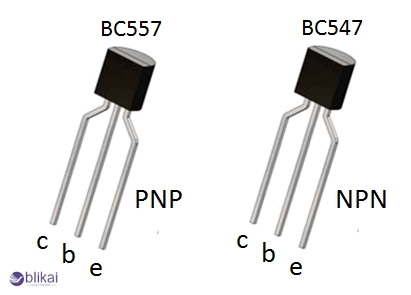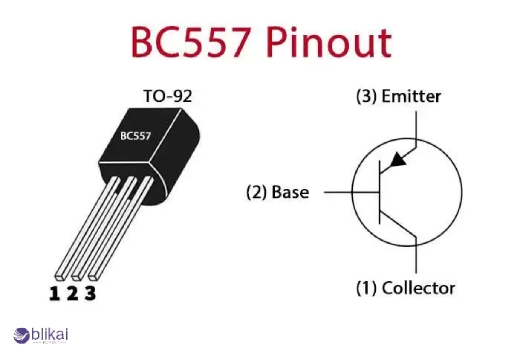BC557 Transistor Pinout, Features & Applications [Electronics Guide]
What is a BC557 transistor?
Within electronics, the BC557 serves as a widely utilized PNP bipolar junction transistor (BJT) type. The BC557 transistor exists among the BC series which demonstrates reliability combined with versatility when used in low-power applications. As a small-signal transistor the device reaches operating efficiency in audio frequencies to handle up to 100mA of current.

Advantages of using BC557 in electronic circuits
Multiple advantages in circuit design make BC557 one of the most popular transistors in the market. The high gain capability makes it suitable for audio amplification and switching systems because of its effective current power amplification. Low noise performance in the transistor proves useful when designing sensitive analog circuits. rẻ availability and affordable price points have made the BC557 suitable for both amateur and professional electronics use. The BC557 proves its worth as a powerful electronic design component because it performs reliably under different operating conditions.
BC557 Transistor Pinout
Identifying the three pins: Emitter, Base, and Collector
The BC557 transistor features three essential pins: the Emitter, Base, and Collector. Proper circuit integration requires correct identification of these pins because they serve as important operational components of the transistor. The Emitter creates charge carriers, and the Base enables current flow, whereas the Collector receives the charge carriers.

Pin configuration and layout
The pins of the BC557 transistor follow the standard TO-92 package format. The combination of Collector Base Emitter appears from left to right along the flat surface when observing the component from its front-facing position.
Differences in pinout between BC557 variants
The fundamental BC557 maintains its basic C-B-E layout, yet various variants might show minor differences between them. Another variant of the BC557B might use a different order for its connection pins. It is necessary to always check the manufacturer's datasheet for the correct pinout information specific to the chosen variant.
Tips for correct pin identification and connection
To ensure proper identification and connection of the BC557 transistor pins, follow these tips:
- Use a multimeter to verify pin identity
- Look for any markings or flat sides on the transistor package
- Double-check the datasheet for your specific BC557 variant
- Use a transistor tester for added certainty
- When in doubt, seek assistance from an experienced electronics professional
BC557 Transistor Specifications
|
Parameter |
Value |
|
Transistor Type |
PNP |
|
Maximum Collector-Emitter Voltage (Vce) |
-45V |
|
Maximum Collector Current (Ic) |
-100 mA |
|
Power Dissipation (Ptot) |
500 mW |
|
DC Current Gain (hFE) |
110 to 800 |
|
Package |
TO-92 |
|
Complementary NPN |
BC547 |
Essential Features of BC557
PNP transistor structure
The BC557 presents itself as a PNP (Positive-Negative-Positive) bipolar junction transistor. Electric current passes from the emitter to the collector through this design when a minimal supply current reaches the base. The PNP configuration enables the BC557 to serve applications that attach their load to the positive supply rail.
Maximum voltage and current ratings
A leading feature of the BC557 transistor pertains to its exceptional current and voltage specifications. The BC557 transistor supports continuous operation under 45V C-E voltage conditions as well as 50V C-B voltage conditions. The BC557 operates at a maximum continuous collector current of 100mA, which allows medium power applications for its usage.
Gain (hFE) characteristics
An outstanding capability of the BC557 is its elevated hFE (current gain). The hFE value of this device ranges between 110 to 800 which creates a high gain parameter essential for various circuit design applications. This wide range of gain enables application designers to optimize their systems according to specific needs.
Temperature and frequency performance
The reliable operational range of the BC557 extends from -55°C to 150°C. The device executes optimally across broad temperature zones that suit numerous operational settings. This transistor achieves its frequency performance through a transition operation of 100 MHz, which supports audio and low-frequency application functions.
Package options and physical dimensions
The BC557 transistors come in the industrial standard TO-92 package, which provides both compact size and design versatility. Through-hole mounting applications, as well as prototyping projects, gain optimal benefits from this package type. These product dimensions of 4.6mm x 4.6mm x 3.9mm allow designers to make circuits that require minimal space.
Common Applications of BC557
Amplification circuits
The BC557 transistor shines best as an amplifier because it provides superior performance in low-noise systems. The BC557 transistor works excellently for amplifying small signals in audio and radio frequency circuits because of its strong current gain (hFE). The BC557 operates effectively in common-emitter layouts to generate voltage gain through minimal distortion output.
Switching applications
Switching applications benefit from using BC557 because the device demonstrates both quick transitioning abilities and minimal saturation voltage. Engineers employ the BC557 in digital circuits level shifter systems and relay driver applications. Pulse-width modulation control functions within different electronic devices because the transistor swiftly switches between cutoff and saturation states.
LED drivers and constant current sources
The BC557 is a widely used component that acts as both an LED driver and a constant current source. The device provides efficient LED brightness control by exploiting its high current gain to manage stable current flow. The BC557 functions well as an indicator light or display backlight component and a simple lighting system since it provides constant illumination.
Audio circuits and preamplifiers
The BC557 operates as a crucial component in preamplifier stages combined with tone control circuits within audio applications. Its low noise performance, together with excellent linearity, enables the BC557 to serve as a top choice in audio projects and inexpensive audio devices.
Power supply and voltage regulation
The BC557 performs work in power supply circuits alongside voltage regulation, even though it does not provide sufficient operation for high-power usage. Microelectronic circuits that employ basic voltage regulation incorporate the transistor to perform current gain functions or operate as a pass component in applications requiring low electrical flow. Due to its thermal stability and predictable behavior patterns the transistor functions effectively for sustaining stable voltage levels inside electronic systems.
BC557 Equivalent Transistors
|
Transistor Model |
Vce (V) |
Ic (A) |
Ptot (W) |
Package |
|
45V |
0.1A |
0.5W |
TO-92 |
|
|
40V |
0.6A |
0.8W |
TO-92 |
|
|
45V |
0.5A |
0.8W |
TO-92 |
|
|
40V |
0.5A |
0.8W |
TO-92 |
|
|
40V |
0.6A |
0.8W |
TO-92 |
Practical Guide to Using BC557
Selecting the right BC557 variant for your project
Select a BC557 transistor according to your circuit requirements before project implementation. Within its product range, the BC557 offers three versions named BC557A, BC557B and BC557C that feature unique gain-bandwidth characteristics. The BC557C transistor possesses the maximum gain band between 420-800, while the BC557B offers 200-450, and the BC557A demonstrates the narrowest 110-220 range. You should choose the specific variable according to your amplifier requirements.
Proper biasing techniques
Correct biasing methods are essential for achieving the best results from the BC557 device. The stable operation requires implementing voltage divider biasing by linking two resistors between the supply voltage and ground with the transistor base placed at their junction. Change the resistors to reach collection current and voltage levels. The addition of a resistor linked between the emitter and ground helps temperature stability in biasing configurations.
Heat dissipation and thermal management
Despite its class as a low-power transistor, heat management remains crucial for this device. Components should maintain proper distance from each other, and heat sinks should be employed for applications that generate higher power. Check the temperature of the transistor during operation in both small and large designs. The implementation of forced air cooling becomes necessary but additional distribution of load through two transistors can also be considered as a solution.
Common circuit configurations and examples
The BC557 transforms signals in multiple configurations due to its versatility. The common-emitter configuration makes the BC557 optimal for amplifier functions as well as switching operations. The common collector (emitter follower) provides improved linearity and higher input impedance. Using the common-base configuration produces benefits for high-frequency applications. Choose different BC557 configurations until you discover the optimal design for your particular project purpose.
Troubleshooting and Best Practices
Identifying faulty BC557 transistors
Begin by viewing the BC557 transistor for external physical damage when trying to find defective components. Examine the casing to detect any burnt marks as well as cracks or deformities. A multimeter should be used to evaluate the transistor operating condition. The multimeter operating in diode mode will help determine the resistance across both base-emitter and base-collector junctions. A properly functioning BC557 has low resistance when checked in one direction but high resistance when checked in the opposite direction. The transistor demonstrates failure when tests from both directions show high resistance or a short circuit.
Avoiding common mistakes in circuit design
The design of BC557 transistor circuits requires observance of the stated voltage and current constraints. Correct device biasing procedures should be used to prevent the transistor from reaching saturation or cutoff states. Choose suitable heat sinks when dealing with high-power situations. Check double times the polarity connections since applying a negative voltage to the wrong terminal can harm the transistor. Protection systems that include current-limiting resistors should be installed for voltage spike defense.
Safety precautions when handling BC557
People should always handle BC557 transistors carefully since electrostatic discharge (ESD) can cause damage. Antistatic wrist straps should be combined with ESD-safe working surfaces. Never deploy direct hand contact with the leads. The usage of a temperature-controlled soldering iron combined with transistor overheating prevention measures will yield proper soldering results. It is important to keep BC557 transistors in antistatic packaging anytime these components are not in use.
FAQs About BC557 Transistor
Q1: Can BC557 be used as a switch?
The device functions adequately for switching systems that operate at low power levels.
Q2: What is the difference between BC547 and BC557?
The transistor BC547 operates as an NPN device, and its PNP counterpart is BC557.
Q3: How do I test a BC557 transistor?
The digital multimeter set to diode testing mode can verify the base-emitter and base-collector junctions of BC557 transistors.
Related Articles
BJT vs MOSFET: Key Differences, Applications, and Choosing the Right Transistor
Transistor Symbol Explained: Understanding the Basics and Types
5477 Transistor Types: Variants, Features & Applications Guide
Infineon IRF3808PBF MOSFET – High Power N-Channel Transistor
IRLZ44N MOSFET Transistor: Specs, Features, and Applications
2N4401 NPN Transistor: Datasheet, Applications, and Features
C945 Transistor: Features, Applications, and Price
Thyristor vs Transistor: What are the Differences?
NPN Transistor? Construction, Working & Applications
2N2222 Transistor: Applications, Features, and Specifications
2SA733 Transistor: Applications, Features, and Specifications
13009D Transistor: Applications, Equivalent and Specifications
BSN254A Transistor: Applications, Datasheet, and Equivalent
2N3904S Transistor: Features, Applications, and Datasheet
PNP Transistor? Construction, Working & Applications










